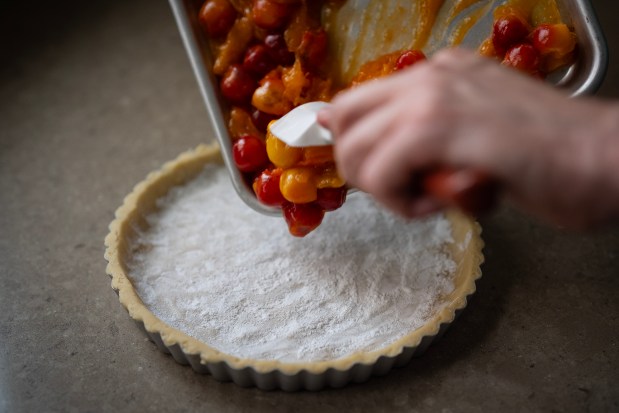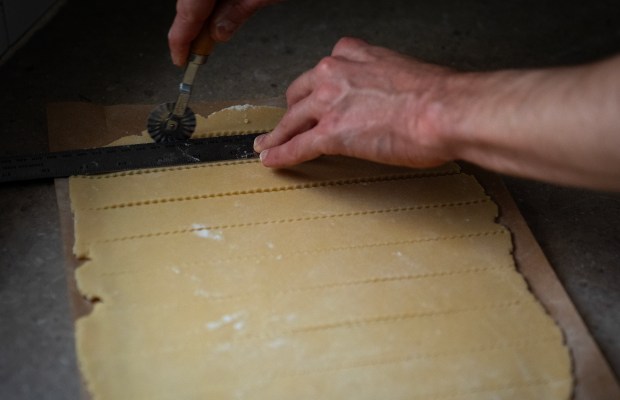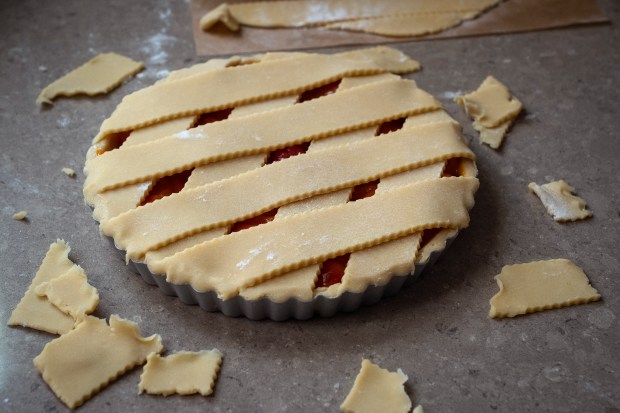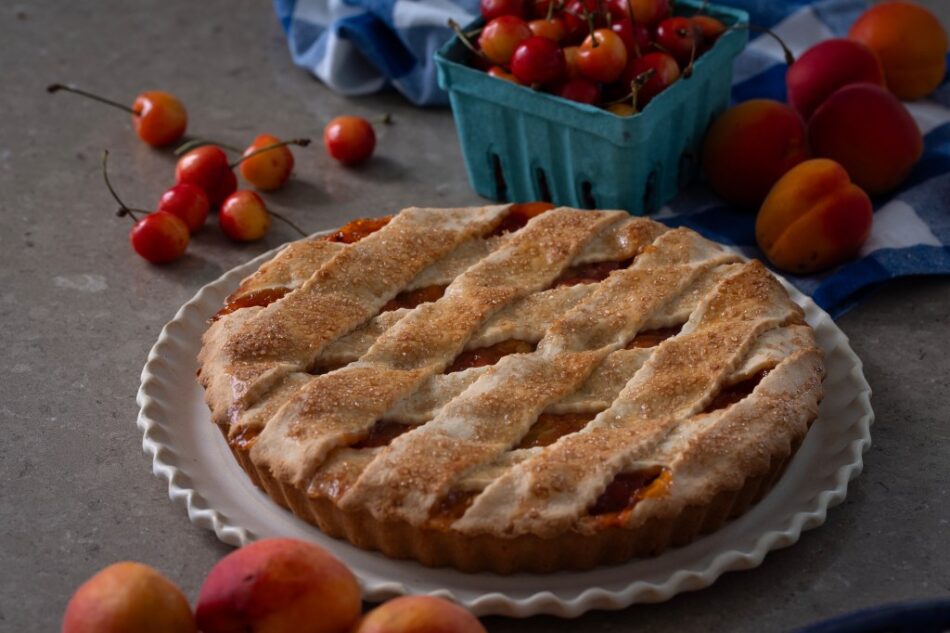Cookbook author, chef and proud Midwesterner Amy Thielen said something on her radio show, “Ham Radio,” that rang true to me. In the winter, heartland cooks delve into recipes or cookbooks to decide what to cook for dinner or bake for dessert, then they head to the grocery store.
In the summer, that gets flipped.
We venture out to the farmers market, our gardens or the grocery store and see what looks best, then we find a recipe that matches nature’s bounty. When you can smell the strawberries from 10 feet away, you buy two quarts and make a fresh strawberry pie. When sweet corn is piled high at a roadside stand, you eat it boiled with butter and salt. When mounds of ripe apricots greet you at the farmers market with a blushing smile, you grab a quart to make a crostata.
Unless those apricots never show up.
Last summer, when apricots normally abound at the stands of two of my favorite stalls at the Lincoln Square Farmers Market, I asked: “When will the apricots be ripe?” Both farmers replied with the same story, “We are so sorry, but a late frost zapped our entire apricot crop this year.”
It got me thinking: Is climate change affecting local farms?
Fruit farming in the Midwest has always been a tricky business. Late frosts, hot summers and frequent hailstorms pose a risk to fragile crops. But a few farmers told me they’ve seen a pattern of changes. Some farmers plant new crops every year, whether that’s soybeans, corn or tomatoes. However, fruit farmers rely on trees and shrubs that produce fruit year after year. They plant for the long term, so they have a different outlook from those who grow annual crops.
Juliette King-McAvoy and the team at King Orchards farm 400 acres, including one of Michigan’s most iconic crops: Montmorency tart cherries. Planted on rolling drumlins alongside the Lake Michigan shore in Central Lake, Michigan, these ruby jewels are big business. Michigan produces approximately 75% of the nation’s tart cherries, which get baked in pies or dried for trail mix. Traverse City is known as the “Cherry Capital of the World.” But climate change is altering what might be viable for the region.
McAvoy says they have seen the effects of climate change in their orchards. The climate isn’t just warmer or colder, it’s more volatile: They might see an 80-degree day in February or a 20-degree day in May. If a hard frost hits after the Montmorency cherry treesblossom, the farmer waves goodbye to that year’s crop. The opposite problem can also affect fruit farmers. Maxx Eichberg, owner of Stranger Wine Co. in Buchanan, Michigan, tends about 22 acres of vines. In 2024, they lost their entire crop, not because of a late frost, but because of an early hard freeze in late 2023.
It’s not only erratic temperatures that cause problems. Rain has been less frequent, but more severe. McAvoy noted that the total amount of rain hasn’t changed much, but instead of consistent precipitation, there are periods of drought and downpour. Storms on dry soils absorb less water than a long, gentle rain on damp soils, plus these storms can erode the soil and flood the orchard. The weather is also getting warmer and more humid for King Orchards, which increases the potential for fungal, bacterial and insect problems.
McAvoy and Eichberg can’t pivot like some farmers. Cherry trees planted this year won’t generate any income for about seven years. Vines need several years to produce viable crops, and even more to produce excellent wines. Both farmers must decide today what varieties will be best suited for the climate over the next 10 to 20 years.
McAvoy notes that the stalwart Montmorency cherries may be among the most vulnerable varieties to climate change. They had total crop failures in 2020 and 2021. This year, they estimate a crop of only 25% of the normal yield. To mitigate these losses, King Orchards has invested in frost fans to warm the orchards, dug drainage ditches to combat flooding and planted additional crops, such as apples, strawberries and raspberry varieties to diversify their portfolio.
Eichberg had to pivot differently — he turned to the community of fellow Michigan winemakers and grape growers. Although Eichberg lost his crop in 2024, the vineyards in Michigan’s pinky finger had a better year. So Bryan Ulbrich, winemaker at Left Foot Charley in Traverse City, and Doug Olson, winemaker at Lake Leelanau’s Boathouse Vineyards, helped Stranger Wine Co. secure about 20 tons of grapes from their region.
Potential solutions to combat and mitigate climate change abound, but there’s one thing that we can all do. We can support our local farmers. This year, I’ll be buying and baking with as many Michigan apricots as I can and toasting their appearance with a bottle of Stranger Wine Co.’s 2024 “Yeastie Boys” sparkling wine.
Apricot & Rainier Cherry Crostata
Time: About 3 hours, plus cooling time.
Rainier cherries, with their sweet peachy flesh, usually get eaten out of hand — their delicate succulence easily overshadowed when baked — except here. The sweet, mild cherries balance out the tangy apricots to create a harmony I couldn’t have predicted. Amaretto amplifies the almond-like notes of these drupes, creating a filling with equal parts mouth-watering tartness and luscious sweetness.
Crostata can refer to various types of rustic pastries. The jam-filled versions that line Italian bakery shelves inspired my take on this classic. I adapted this recipe from my friend and fellow “Great American Baking Show” winner, Tina Zaccardi.
Ingredients for the filling:
300 g (about 10½ ounces) fresh apricots, halved and pitted (measured after pitting)
300 g (about 10½ ounces) pitted fresh Rainier or Queen Anne cherries (measured after pitting)
100 g (½ cup) sugar, divided
2 Tablespoons amaretto (or ¼ teaspoon almond extract and 2 Tablespoons water)
1 Tablespoon lemon juice
1/4 teaspoon fine sea salt
18 g (2 Tablespoons) cornstarch
2 Tablespoons rice flour or dried breadcrumbs
Directions:
1. Cut each apricot half into four slices.
2. Place the apricots, pitted cherries, amaretto, lemon juice, salt and 50 g (¼ cup) sugar in a medium saucepan, stir and let sit for 10 minutes to draw some water out of the fruit.
3. Whisk together 50 g (¼ cup) sugar and the cornstarch in a small bowl until combined and set aside.

4. Bring the fruit mixture to a light simmer over medium heat while stirring gently. Simmer, stirring occasionally, until the fruit has just softened, about 6-8 minutes.
5. Add the cornstarch mixture and stir. After a few minutes, it will start to thicken and a few bubbles will pop.
6. Cook for 1 full minute after you see the first bubble. Scrape the filling into a bowl, cover it and chill it for at least 2 hours or until completely cold. (You can cool the filling faster by spreading it out on a sheet pan to chill.) This filling can be made a day ahead.
Ingredients for the crust:
360 g (2¾ cups plus 1 Tablespoon) all-purpose flour
80 g (about 2/3 cup) powdered sugar
40 g (1/3 cup minus 1 teaspoon) rice flour (or more all-purpose flour)
1 teaspoon fine sea salt
227 g (1 cup) unsalted butter, cold and cubed
1 large egg, cold
1 Tablespoon cold water
1 teaspoon vanilla extract
Ingredients for the egg wash and topping:
1 egg
Pinch of salt
About 1 Tablespoon coarse turbinado sugar
Directions:
1. Heat the oven to 375 degrees Fahrenheit with a rack in the oven’s lowest position.
2. Add flour, powdered sugar, rice flour and salt into the bowl of a food processor. Pulse five times to combine.
3. Add the cubed butter to the food processor and pulse until the mixture resembles fine breadcrumbs, about 10-15 one-second pulses.
4. Add the egg, water and vanilla extract to the food processor and pulse until the dough starts to come together into a ball and holds together when squeezed, about 10-15 one-second pulses.
5. Dump the dough onto the counter and gather it into a ball. Divide the dough in half.
6. Press one piece of dough into a ½-inch-thick square, wrap it in plastic wrap, and chill it in the refrigerator until needed.
7. Line the tart pan: Take the second disc and press it into a 9½-inch round, 1-inch deep tart pan with a removable bottom, making sure the dough is an even 1/8-inch thick around the bottom and the sides. Trim off any excess dough that extends above the rim of the tart pan. Put the tart shell in the freezer for at least 15 minutes to firm up.
8. Remove the tart shell from the freezer and the filling from the refrigerator. Sprinkle the bottom of the pastry with rice flour or breadcrumbs. Pour the filling into the lined tart shell and spread it evenly. It should be about 1/8 inch below the top edge of the pastry, no higher.
9. Remove the square of dough from the refrigerator and dust it with flour. Roll the dough about 1/8-inch thick, dusting with more flour as you go to keep it from sticking to the counter or the rolling pin.
10. Cut 1-inch-wide strips of pastry dough using a pizza wheel or a long chef’s knife and a ruler.


11. Dampen the rim of the crust with a bit of water, which will help the pastry strips adhere. Place the strips of pastry parallel to each other, with about ½ inch of space between them, on top of the pastry, and press the edges lightly to adhere.
12. Place another row of pastry strips at a 45-degree angle from the first row of strips to create a diamond-like pattern.
13. Trim off the excess pastry using your fingers or a paring knife. Gather any pastry scraps into a disc, wrap in plastic, and refrigerate. (Never throw away extra pastry dough.)
14. Make the egg wash by whisking together the egg and salt.
15. Brush the top crust with the egg wash and sprinkle with turbinado sugar.
16. Transfer the tart to a baking sheet to catch any drips.
17. Bake on the lower rack of the oven at 375 degrees Fahrenheit until deep golden brown on top, about 42-46 minutes. This crostata should have a strong color, which ensures crispness.
18. Take the tart out of the oven and carefully remove it from the baking sheet and place it on a wire rack to cool. Cool completely. Remove the crostata from the tart pan and put it on a serving platter.
This tart is best served the same day it’s made. It still tastes great on the second day, but the crust will soften.
Bonus: Pastry Scrap Shortbread Cookies
This crostata dough is, in essence, shortbread cookie dough with a bit of egg. Throwing away pastry dough trimmings is blasphemy: You can always turn them into something. These little melt-in-your-mouth cookies make simple, scrumptious treats.
Directions:
1. After you’ve baked the crostata, turn the oven down to 300 degrees Fahrenheit and place a rack in the middle position.
2. Gather the leftover crostata crust scraps together and knead them a few times to create a cohesive dough.
3. Put the dough on a lightly floured piece of parchment, and roll it until it is just shy of ¼-inch thick.
4. Transfer the dough to a sheet pan and chill in the refrigerator for 30 minutes, up to an hour.
5. Take the dough out of the refrigerator, and using a pizza roller or chef’s knife, cut the dough into one-inch-wide strips. At a 45-degree angle, cut the dough again, creating diamond shapes. Use a fork to poke holes in the center of each diamond to keep it from puffing up too much.
6. Brush the dough with a thin layer of egg wash and sprinkle generously with turbinado sugar.
7. Bake until slightly puffed and just turning a blonde shade of golden brown on top, about 30 minutes.
8. Immediately after you take the cookies out of the oven, recut them along the scored lines to separate, if necessary. Let the cookies cool for about 10 minutes, then separate them and set them on a cooling rack to cool completely.
Martin Sorge is a freelance writer.







